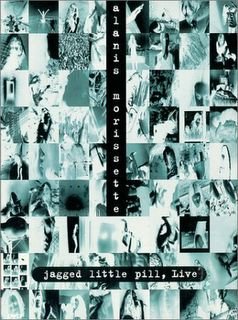This purpose of this blog is to put together a virtual list/collection of memorable (if fleeting) references to the cities of Wilkes-Barre, PA or Scranton, PA in movies/TV/music/Broadway/books (in the script, setting, lyrics, etc). We'd like to thank everyone for the overwhelming support and suggestions for the Entertainment blog. I'll continue adding these as blog entries as time permits.
Tuesday, July 25, 2006
Alanis Morissette: Jagged Little Pill Live (1997)
One scene in the documentary shows her band (sans Alanis) rehearsing for a concert at the Marts Center at Wilkes University in Wilkes-Barre, PA on December 5, 1995.
Monday, July 24, 2006
Sweet Charity (1966 musical, 1969 film)

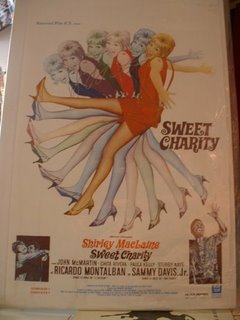
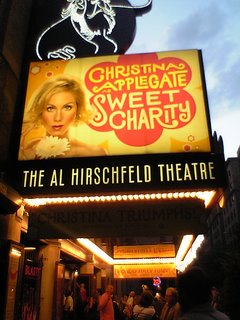
The fantabulous Sarah Reid (who also gave us the Scranton reference in the movie musical Finian's Rainbow) found another Scranton reference in another classic musical--Sweet Charity.
Sweet Charity tells the story of Charity Hope Valentine, a lovelorn New York City dance hall hostess who dreams of having an old-fashioned romance--despite the fact that she repeatedly falls for Mr. Wrong. The musical is responsible for such classics as Big Spender, If They Could See Me Now, There's Gotta Be Something Better Than This, Where Am I Going, and I'm A Brass Band.
Music was written by Cy Coleman (Wildcat with Lucille Ball, The Will Rogers Follies, The Life), and lyrics by Dorothy Fields (Annie Get Your Gun, Ain't Misbehavin'). The book of the musical (based on the film Nights of Cabiria by Federico Fellini) was written by Neil Simon (The Odd Couple, The Sunshine Boys, Barefoot in the Park).
The Scranton reference appears in the beginning of Act II. Charity's latest beau Oscar invites her to go to church with him. She accepts and soon learns that Oscar's church is a little unusual, where their leader Daddy Johann Sebastian Brubeck preaches mostly of welfare and drug resolutions. Daddy Johann breaks out into a song titled Rhythm of Life, which includes the following lyrics:
You can read the complete lyrics to Rhythm of Life by clicking here.
The original Broadway musical debuted in January 1966 and starred Gwen Verdon in the title role; it played for over 600 performances at the Palace Theater. The show was revived on Broadway in 1987 with Debbie Allen and Bebe Neuwirth. Ironically, the 2005 Broadway revival of Sweet Charity, starring Christina Applegate, was directed by none other than Scranton native Walter Bobbie.
A film version starring Shirley Maclaine and directed by Bob Fosse (Broadway's Chicago in 1975 and the films Cabaret and All That Jazz) was released in 1969. Sammy Davis Jr. performs Rhythm of Life in the film.
The DVD of the film version of Sweet Charity is available to borrow from the Lackawanna County Library System. Click here to place a hold; if you'd like to reserve the CD soundtrack of the original Broadway cast recording, click here.
Much thanks again to Miss Sarah for another great Scranton musical reference.
Friday, July 21, 2006
The X-Files (1993-2002)

I received an email from Rob McIlvried this week, and he told me that he recalls several references to Scranton in an episode of the hit sci-fi series The X-Files.
The X-Files, which ran for 9 seasons from 1993 to 2002 on FOX (and continues to live on in reruns on the Sci-Fi Channel) stars Gillian Anderson and David Duchovny as two FBI agents, Fox Mulder (the believer) and Dana Scully (the skeptic) as they investigate the strange and unexplained while hidden forces work to impede their efforts.
The Scranton references occur in the first of a two-part episode in the second season titled Colony that originally aired on February 10th, 1994. In Colony, a newspaper ad placed to locate a certain doctor sets off the murder of several people with the same face. When Scully and Mulder locate another look-alike, they work to find him before the killer does. The episode also marks the first appearance of Agent Mulder's mother and father.
Both verbal references to Scranton are made by Agent Mulder (Duchovny). Scranton also appears as the setting of two scenes in Colony.
Following a scene set in the Woman's Care Family Services and Clinic in Scranton, Pennsylvania, Mulder and Scully have the following exchange at the FBI Headquarters in Washington, D.C.:
MULDER: I found these in my e-mail this morning... three obituaries.
SCULLY: Sent by whom?
MULDER: Nobody I know but obviously somebody who knows me.
(He clicks on a few keys and the text box expands on the monitor.)
SCULLY: Why?
MULDER: The deceased are Doctor Landon Prince of Scranton, Pennsylvania...
(He expands another box.)
Doctor Dale Gayhart of New York City...
(He brings up the third obituary.)
...and Doctor Harvey Buchanon of Tea Neck, New Jersey. All worked in abortion clinics. They died in separate arson fires.
Following the next brief scene set in Scranton, Pennsylvania, Mulder and Scully continue their investigation at the Globe and Mail in Binghamton, NY, where the city of Scranton is once again mentioned in the following dialogue:
(Mulder looks at a map. He goes over to it, Scully following.)
MULDER: If somebody really wanted to set us up, would they give us this little to go on? There's something bigger here, Scully. I'd be willing to bet there are more of these guys out there.
SCULLY: More victims?
MULDER: Unless we get to them first. The deaths follow a pattern... New Jersey, New York, Scranton...
The full script of the X-Files episode Colony can be ready online by clicking here.
Rob McIlvried also told me the show made several references to other areas of Northeastern Pennsylvania throughout its nine-season run.
Much thanks again to the clever eyes and ears of Rob McIlvried for this reference.
Tuesday, July 11, 2006
Judy McLane, Broadway Actress

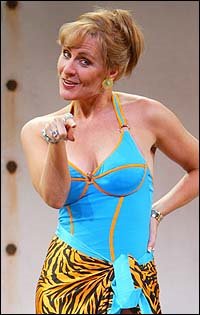

If you're in New York City and attend a performance of the hit musical Mamma Mia! (based on the songs of ABBA) at the Cadillac Winter Garden Theatre, you'll be seeing a native from the Scranton area performing the role of Tania.
Broadway actress Judy McLane was born in Olyphant, PA, though she proudly states in interviews that she was "raised near Scranton, Pennsylvania."
Coincidentally, Mamma Mia! is not McLane's first Broadway experience with a show written by ABBA founders Benny Anderson and Bjorn Ulvaeus - in 1988, she understudied the role of Florence in their short-lived Broadway production of Chess.
An article about McLane's neighbors visiting the actress backstage after a performance of Mamma Mia! in New York City ("My, My, Backstage At the Show, Again") was published in the Namedropper section of the Scranton Times on Friday, June 30, 2006 (page C2) . You can read the full article online at the Scranton Times website by clicking here.
If you can't get to New York to see Mamma Mia! on Broadway, the official tour will be returning to the Scranton Cultural Center from October 24th through the 29th.
Thank again to endless fountain Judi K. for another great reference.
The Office Nominated For 5 Emmys

The hit NBC show The Office, which takes places at the ficticious Dunder-Mifflin paper distribution company in Scranton, PA (and has included several local references throughout its two seasons) has been nominated for 5 Emmy Awards, including Best Comedy Series and Best Actor in a Comedy for star Steve Carell.
Monday, July 10, 2006
Rebecca Anderson, Extra in Pirates of the Caribbean: Dead Man's Chest (2006)
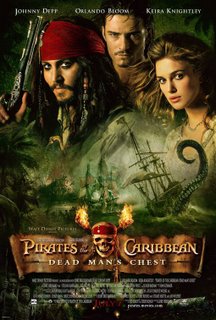
While working as a crew member on the H.M.S. Bounty (a restored ship constructed for the 1962 classic Mutiny on the Bounty), Scranton native Rebecca Anderson was offered the chance to work as an extra in the recently released, record-setting blockbuster Pirates of the Caribbean: Dead Man's Chest, starring Johnny Depp, Orlando Bloom, and Keira Knightley.
Scranton Times staff writer Josh McCauliffe recently wrote an article ("City Native Gets Part, Look Behind Scenes") about Anderson; it appeared in the Friday, July 7th, 2006 Lifestyles section of the Scranton Times. The article is also avaiable online from the Scranton Times website under the title "Local Woman in 'Pirates'".
In addition, webmaster James Minor wrote an article that mentions Rebecca Anderson on his website; the article is titled Discovering the H.M.S. Bounty that appeared on July 17, 2005.
Much thanks to Judi K. for the reference.
Also a great big THANK YOU to Scranton Times librarian Brian Fulton for locating the online article for me.
Saturday, July 08, 2006
Finian's Rainbow (1968)
 The divine Sarah Reid (or Miss Sarah, as she is known to the younger set) from the Lackawanna County Children's Library, recently told me of a film musical titled Finian's Rainbow whose lyrics literally ask Scranton, Pennsylvanians to beget (to sire, procreate or produce, especially as an effect or outgrowth).
The divine Sarah Reid (or Miss Sarah, as she is known to the younger set) from the Lackawanna County Children's Library, recently told me of a film musical titled Finian's Rainbow whose lyrics literally ask Scranton, Pennsylvanians to beget (to sire, procreate or produce, especially as an effect or outgrowth).Finian's Rainbow began as a Broadway show that opened in January 1948 and played for nearly 2 years and over 720 performances. Lyrics were written by E.Y. Harburg (1939's The Wizard of Oz) and Fred Saidy (Star-Spangled Rhythm), and the score was written by Burton Lane (On A Clear Day, You Can See Forever, Cafe Society).
The film stars the legendary Fred Astaire (Top Hat, Funny Face with Audrey Hepburn) and songstress Petula Clark (the #1 hit single Downtown); it was directed by Francis Ford Coppola (The Godfather, Apocalypse Now).
Both the musical and the 1968 film version of Finian's Rainbow tell the story of mysterious Irishman, Finian, and his beautiful daughter Sharon, who arrive one day in a small Southern town of sharecroppers. The town has its own dreamer who thinks that he might be able to put the town on the map by crossing mint with tobacco so that it'll come mentholated. Fianian's journeyed to the town because he's captured a leprechaun's crock of gold and plans to plant it in the ground so it'll grow faster; but Og the leprechaun arrives, bent on retrieving his gold. Meanwhile, the bigoted Judge Hawkins is upset with the tobacco growers because they're not segregated, and plans on taking their land away. And when Sharon yells, "I wish to God you were black so you could know how it feels..." while standing right over the pot of gold, all hell breaks loose as wishes come true.
Near the end of the film, Senator Billboard Rawkins and the Passion Pilgrim Gospellers break out into a song titled The Beget. Scranton is mentioned in the lyric section below:
To read the complete lyrics to The Beget, as well as the full score of Finian's Rainbow, click here.
The DVD and VHS of Finian's Rainbow are available to borrow from The Lackawanna County Library System; to place a hold, click here. The CD soundtrack of the 1960 Broadway revival of Finian's Rainbow is also available to borrow--a hold can be placed by clicking here.
For more information about the original Broadway musical, visit The Internet Broadway Database.
For more information on the 1968 film version, visit The Internet Movie Database.
Much thanks again to the exquisite Miss Sarah for this reference.
Thursday, July 06, 2006
Lauren Weisberger (1977- )

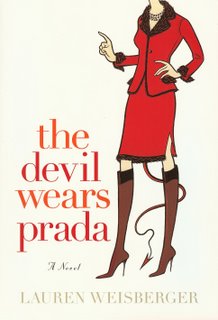
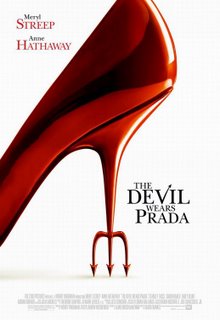
Did you know that the author of the bestselling book The Devil Wears Prada (now a major motion picture starring Meryl Streep), the ultimate tale of the boss from hell, was born and raised in Scranton, PA?
Lauren Weisberger was born in Scranton, Pennsylvania on March 28, 1977. She lived in Scranton for 11 years before moving to Allentown, PA. She graduated from Cornell University with a BA in English in 1999 and spend some time to travel allover the world. Upon her return to the US, she worked as an Assistant to Editor-in-Chief of Vogue Magazine, Anna Wintour.
Her experiences at Vogue inspired Weisberger to write her first novel, The Devil Wears Prada, the story of recent college grad and aspiring writer Andrea Sachs. Though she dreams of writing for The New Yorker, circumstance leads Andrea to a one-year tenure working as an assistant to Miranda Priestly, editor-in-chief of Runway Magazine. One year soon feels like twenty to Andrea as she, in short, spends the year listening to Miranda says "Jump!" and is forced to answer "Off which bridge?" to Miranda's incredible and outrageous demands.
In April 2003, at the age of 26, Weisberger's first novel, The Devil Wears Prada, became an immediate bestseller. Her second novel, Everyone Worth Knowing, was published in October 2005 and was also a bestseller. She is working on her third novel.
In July 2006, a film version of The Devil Wears Prada was released to great reviews and big box office. The film stars Meryl Streep as Miranda Priestly and Anne Hathaway as Andrea Sachs.
Both of Weisberger's novels, The Devil Wears Prada and Everyone Worth Knowing, (including audio book versions) are available to borrow from Albright Memorial Library, as well as from other libraries throughout the Lackawanna County Library System.
Much thanks to Judi K. for this reference.
Photos of Lauren Weisberger and book jacket courtesy of press page on Miss Weisberger's official web site.
Thursday, June 22, 2006
Walter Bobbie (1945- )



Do you remember that hilarious scene in the 1996 comedy The First Wives Club when Bette Midler, Goldie Hawn and Diane Keaton are rapidly descending outside an upscale Manhattan apartment building on a window washing platform? Do you also remember when it suddenly stopped and a couple making out in bed told Elise Elloitt (Goldie Hawn) "You look great!!!!!"? Well, not only was that actor born in Scranton, PA, but he has also had a prolific and Tony-winning career as a Broadway actor, writer and director--most notably for directing the long-running Broadway revival of Chicago. He is Walter Bobbie.
Walter Bobbie was born in Scranton, Pennsylvania on November 18, 1945.
His TV acting credits include episodes of Hill Street Blues, L.A. Law, NYPD Blue, Law & Order, and the ABC soap operas Loving and One Life To Live, on which he plays the recurring role of William Davis Dawes. His film appearances include Stephen King's Thinner, Shakedown and, of course, his brief-but-memorable appearance in The First Wives Club.
Bobbie's major successes came on Broadway--first as an actor in the original Broadway production of Grease and the revivals of Guys and Dolls and Anything Goes. He conceived and directed the 1993 Broadway musical A Grand Night For Singing. In 1998, he adapted and directed the musical Footloose, based on the 1984 film.
Perhaps Bobbie's most famous achievement is directing the 1996 Broadway revivial of Chicago, for which he won the Tony Award for Best Director. Chicago is currently the longest-running revival of a musical in Broadway history, and it continues to play to sell-out crowds on The Great White Way.
He also directed the 2005 Broadway revivial of Sweet Charity, starring Christina Applegate (which features Scranton in the one the lyrics of the classic songbook).
Bobbie is currently preparing to direct the musical adaptation of the novel/movie High Fidelity, which is set to open on Broadway in November/December 2006.
The First Wives Club is available to borrow on VHS from Albright Memorial Library and other libraries throughout the Lackawanna County Library System.
For more information on Mr. Bobbie's Broadway career, visit The Internet Broadway Database.
Saturday, June 10, 2006
There's No Business Like Show Business (1954)

The razor-sharp-eared Don McKeon told me of a brief mention of Scranton in the 1954 musical comedy There's No Business Like Show Business.
Titled after the classic Irving Berlin song, There's No Business Like Show Business tells the story of travelling vaudevillians The Five Donahues, headed by parents Molly (Ethel Merman) and Terry Donahue (Dan Dailey) and featuring their three children. When their son Tim (Donald O'Connor) meets hat check girl Vicky (Marilyn Monroe), the family act begins to fall apart.
Early on in the film, Molly and Terry are at a train station with their young children discussing whether or not life on the road is good for a family. Suddenly, over the loudspeaker comes:
Wednesday, June 07, 2006
Citizen Kane (1941)
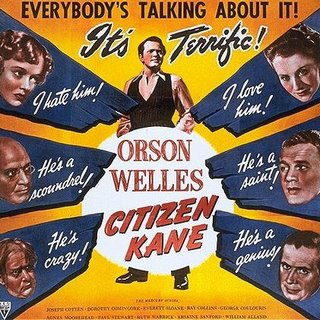
While working on the entry for A Letter To Three Wives earlier this week, the Head of Reference Evelyn Gibbons asked me, "Did you know that Citizen Kane was inspired by a bike stolen from the front of Osterhout Library?" My first thought was, "How can this possibly be true?" So she told me to the call the Reference Department at Osterhout Free Library to confirm this and, sure enough, they faxed me an article that proved this, indeed, was a fact (not that I didn't believe Evelyn, of course, but this reference is truly remarkable). But can you believe that Citizen Kane, considered by many to be the greatest American film ever made, was inspired by a true incident in Wilkes-Barre, PA?
The Oscar-winning screenplay for Citizen Kane was written by Herman Mankiewicz, brother of Joseph L. Mankiewicz--Joseph often worked the city of Wilkes-Barre (his birthplace and hometown) into his scripts, two of which (All About Eve and A Letter To Three Wives) won back-to-back Oscars for Best Screenplay in 1949 and 1950. Although Joseph's brother Herman was born in New York City in 1897, he lived in Wilkes-Barre for nine years as a boy.
The article, "Listen Up, Cinema Sleuths: Rosebud Was Really A Bike" by Times Leader Staff Writer Joe Butkiewicz, was originally published on May 1, 1991. In the article, Butkiewicz referenced a biography of Herman Mankiewicz by Richard Merryman titled, Mank: The Wit, World and Life of Herman Mankiewicz.
According to the article and the biography, Herman received a bicycle for Christmas at the age of 10. One day, Herman went to the local public library (the name of the library is not mentioned, but the assumption is the library was the Osterhout in Wilkes-Barre) and parked his bicycle outside--when he left the library some time later, "Rosebud"was missing and presumed stolen. As punishment, Herman's parents never replaced his lost/stolen bicycle, instead telling him the incident was his own fault.
Co-written by, directed by, and starring Orson Welles, Citizen Kane tells the story of the death of publishing tycoon Charles Foster Kane and the ensuing search by news reporters to discover the meaning of his final utterance--"Rosebud."
SPOILER ALERT
In the film, "Rosebud" was the name of the sled Kane had as a young boy and represented the happiest time of his life--his childhood.
In real life, "Rosebud" was the nickname of the bike Herman Mankiewicz had as a young boy that his parents refused to replace when it was stolen from the front of a public library in Wilkes-Barre, PA. In turn, this incident of childhood loss inspired a masterpiece that will live on for generations.
END OF SPOILER ALERT
A copy of the Times Leader article "Listen Up, Cinema Sleuths: Rosebud Was Really A Bike" by Joe Butkiewicz is available in the "Movies" Local History Vertical File in the Reference Department.
My deepest thanks to both Evelyn Gibbons and the Reference Staff at the Osterhout Free Library for this reference.
A Letter To Three Wives (1949)
My wonderful brother J.R. told me some time ago of a reference to the city of Wilkes-Barre in the 1949 Academy Award-winning film A Letter To Three Wives, written and directed by Joseph L. Mankiewicz.
Mankiewicz, who was born in Wilkes-Barre, also wrote the screenplay to All About Eve, which also included a reference to Wilkes-Barre in the dialogue (All About Eve was also the inaugural entry in this blog). Coincidentally, both A Letter To Three Wives (1949) and All About Eve (1950) won back-to-back Oscars for Best Screenplay (as well as Best Director) for Mankiewicz, the only such occurrence in the history of the Academy Awards. This distinction gives Wilkes-Barre, PA an ultra-rare (though unnoted until now) historic footnote in the history of cinema—city references included in two screenplays by the same author that won two consecutive Oscars.
Joseph L. Mankiewicz was born in Wilkes-Barre, PA on February 11, 1909. He began his career in film as a translator of intertitles for Paramount in Berlin. Upon returning to Hollywood, he worked as both a screenwriter and producer throughout the thirties and forties; he also produced several films starring Joan Crawford (including 1942's Reunion in France, which features several references to Wilkes-Barre). After directing his first film Backfire in 1946, Mankiewicz went on to direct such classics as The Ghost and Mrs. Muir, Now Way Out, Guys and Dolls, Cleopatra and, of course, All About Eve—which still holds the record of the most Academy Award nominations (14) in film history (tied with Titanic).
A Letter to Three Wives stars Jeanne Crain (State Fair, Cheaper By The Dozen), Linda Darnell (Mankiewicz’s No Way Out, Unfaithfully Yours) and Ann Sothern (Lady in the Lark, The Whales of August) as three friends in an affluent neighborhood. As they are boarding a ship to chaperone a school trip, a mailman delivers a letter addressed to the three of them from their friend (and town floozy) Addie Ross. Addie writes that she is leaving town for good and taking one of their husbands as a momento—neglecting to reveal exactly whose husband she stole. Though they display a brave front and a nonchalant attitude, each of the three women spends the day reminiscing about the ups and downs of her marriage -- wondering if hers is the husband who has flown the coop.
The Wilkes-Barre reference occurs during the flashback of “wife” Rita Phipps (played by Ann Sothern), a writer for radio shows. As she is having dinner with her possibly straying husband George (Kirk Douglas) and her radio show’s sponsors, a commercial for a breath mint begins playing during the radio show “Confessions of Brenda Brown.”
Announcer:
On the audio commentary on the DVD of A Letter To Three Wives (at 48:00), Joseph Mankiewicz's son Christopher explains that his father "never missed a chance in any screenplay that he wrote to pay homage to his city of birth and get it in the script."
A Letter to Three Wives is available for loan on DVD from the Lackawanna County Library System. To place a hold on the DVD, click here; to reserve the VHS, click here.
Monday, June 05, 2006
New York, New York (1977)
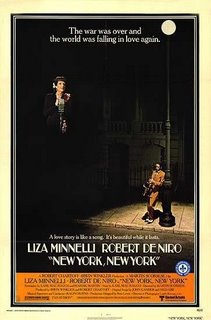
The ever-sharp RY recently told me about a brief visual reference to the city of Scranton in the 1977 film New York, New York.
Directed by Martin Scorsese (Taxi Driver, Goodfellas, The Aviator), New York, New York stars Liza Minnelli (Cabaret, Arthur) and Scorsese regular Robert de Niro (Goodfellas, The Deer Hunter, Meet The Parents).
The film has been described as Scorsese’s musical tribute to his hometown. The day WWII ends, selfish and smooth-talking saxophonist Jimmy (de Niro) meets lounge singer Francine (Minnelli). From that moment on, their relationship grows into love as they struggle with their careers and aim for the top in the era of Big Band.
An extended section of the film shows Jimmy and Francine touring with a big band by bus throughout the country, punctuated by signs of towns they played and musical performances. One of the signs the bus passes reads “SCRANTON, 741 FT.”
The DVD of New York, New York can be borrowed through the Lackawanna County Library System; to place a hold, click here.
Much thanks again to RY for this reference.
Friday, June 02, 2006
Michael Schoeffling (1960- )
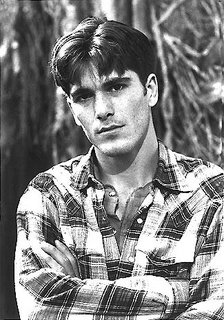
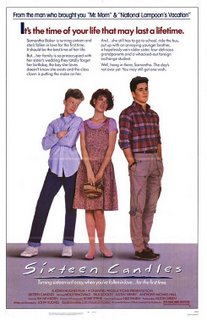 Any child of the 80s (like me) is most likely endeared to the films of John Hughes, whose films (including The Breakfast Club, Pretty in Pink and Some Kind of Wonderful) have served as sort-of a coming-of-age rite of passage for teens in that decade. His directorial debut, Sixteen Candles, featured a native of Wilkes-Barre as the epitomical dream date, Jake Ryan.
Any child of the 80s (like me) is most likely endeared to the films of John Hughes, whose films (including The Breakfast Club, Pretty in Pink and Some Kind of Wonderful) have served as sort-of a coming-of-age rite of passage for teens in that decade. His directorial debut, Sixteen Candles, featured a native of Wilkes-Barre as the epitomical dream date, Jake Ryan.Sixteen Candles tells the story of Samantha Baker (Molly Ringwald) whose parents, caught up in preparations of the wedding of their other daughter, completely forget about her 16th birthday. Visting relatives, an exchange student by the name of Long Duck Dong, and an obsessive geek don't make Samantha's forgotten birthday any better. The sole hope she clings to is her crush on high school senior (and birthday dream date) Jake Ryan, played by Wilkes-Barre native Michael Schoeffling.
Born in Wilkes-Barre on December 10, 1960 and raised in New Jersey, Michael Schoeffling studied acting at Temple University and the Lee Strassberg Institute, and he also became a model whose photographs were featured in magazines such as GQ.
Schoeffling's first major film role was as the "dreamy" Jake Ryan in Sixteen Candles. His later film credits include Vision Quest (with Matthew Modine and Madonna), Sylvester (with Melissa Gilbert), Merchant Ivory's underrated comedy Slaves of New York (a look at the 1980s New York art scene, with Bernadette Peters), Longtime Companion (one of the first films to directly address the AIDS crisis) and Mermaids (with Cher and Winona Ryder). Schoeffling last appeared on screen in Walt Disney's Wild Hearts Can't Be Broken in 1991.
A Google! search for his name results in a list of several websites that pose the question, "Whatever happened to Michael Schoeffling or "Jake Ryan?".
After taking a permanent break from acting in the early 1990s, Michael Schoeffling opened (and still operates) a handcrafted furniture store in Northeastern Pennsylvania, where he presently lives quietly and out of the limelight with his family.
Sixteen Candles and Wild Hearts Can't Be Broken are all available to borrow on VHS from the Lackawanna County Library System.
You can watch the movie trailer for Sixteen Candles by clicking here.
Thursday, June 01, 2006
Edmund “Buster” Piaski, Olympian (1915-1995)
 Edmund “Buster” Piaski, who grew up in Moosic, competed in the Polish Olympics in Warsaw in 1934. Piaski placed third in the high jump and fourth in the 800-meter race.
Edmund “Buster” Piaski, who grew up in Moosic, competed in the Polish Olympics in Warsaw in 1934. Piaski placed third in the high jump and fourth in the 800-meter race.In 2004, Moosic Borough officials dedicated Elm Street Park in Piaski's memory.
An article in the Scranton Times from July 4, 2004, titled "Moosic Honors Former Athlete," can be read online by clicking here.
The Reference Department has a "Sports-Olympics" Local History Vertical File containing newspaper clippings about Piaski; the file also contains an article about Dr. Walter Tewsbury of Tunkhannock, who won five medals (two gold, two silver, and a bronze) at the Paris Olympic Games of 1900.
Much thanks to Judi K. for the information included in this entry.
Wednesday, May 24, 2006
Gloria Jean, Actress (1926- )
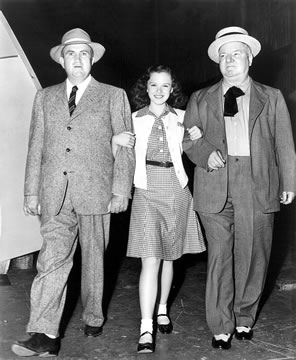 Actress and former Scranton resident Gloria Jean (center) with Leon Errel and W.C. Fields in a publicity photo for 1941's Never Give A Sucker An Even Break. My deepest thanks to Gloria Jean's sister (and webmaster of her official site http://www.gloriajeanchildstar.com/) Bonnie Schoonover for giving me permission to use this photo in our blog.
Actress and former Scranton resident Gloria Jean (center) with Leon Errel and W.C. Fields in a publicity photo for 1941's Never Give A Sucker An Even Break. My deepest thanks to Gloria Jean's sister (and webmaster of her official site http://www.gloriajeanchildstar.com/) Bonnie Schoonover for giving me permission to use this photo in our blog. Thanks again to Don McKeon for providing me information for this entry.
Also, thank you to Bonnie Schoonover for information on the book Gloria Jean: A Little Bit of Heaven and for her permission to use the fantastic movie still in our blog.
Monday, May 22, 2006
The Ghost Breakers (1940)

Don McKeon recently emailed me the following:
"I was watching an old movie recently called The Ghost Breakers made in 1940 starring Bob Hope and Paulette Goddard. A reference was made to Scranton when both Bob Hope and Paulette Goddard come across a set of railroad tracks in a secret room of a castle. Bob Hope said that the tracks reminded him of his hotel room in Scranton."
Directed by George Marshall (Marlene Dietrich’s “comeback” film Destry Rides Again, as well as Bob Hope and Lucille Ball in the film Fancy Pants and Ball again in episodes of her TV series Here’s Lucy) this breezy, timelessly amusing comedy re-teams Bob Hope and Paulette Goddard, who two years earlier appeared together in The Cat and the Canary.
Mary Carter (Goddard) has just inherited a castle owned by her great-great grandfather off the coast of Cuba and said to be haunted. Despite warnings and death threats, she accepts the inheritence.
She is joined by radio broadcaster Larry Lawrence (Hope) who, believing he has killed a mob boss, flees New York with his butler, Alex (Willie Best). She enables him to escape by stowing him in a trunk bound for Cuba. In return, he promises to help rid her inherited castle of the ghosts and ghoulish creatures said to inhabit it. Once on the island, the three explore the eerie castle and search for the key to the castle's treasure while being haunted by the ghosts of Mary's ancestors.
Hope proves yet again that he is the master of the one-liner. The following dialogue is spoken as Mary and Larry descend a staircase into the dungeon of the castle.
The Ghost Breakers is available to borrow on VHS from The Lackawanna County Library System; to place a hold, click here. The film is also available to purchase on DVD.
Much thanks again to Don McKeon for the reference.
Thursday, May 18, 2006
The Miracle of The Bells (1948)

The ever-observant Michele Murphy has recently told me about a classic film that makes several references to Wilkes-Barre and Nanticoke.
Olga
I was born in Poland. When I was quite young, we came to America to a place in Pennsylvania called…Coal Town. Little Poland.
Bill
Near Wilkes-Barre?
Olga
Yes.
Nick
Didn’t keep ya’ waiting too long, I hope?
Bill
Ya' got everything fixed?
Nick
Yessiree. I had a big talk with Father Spinsky, and he worked everything out fine. He’s gonna’ give ya’ a solid requiem mass. And I got hold of a singer from Wilkes-Barre. She just happened to be in town.
Nick
In additional to the Wilkes-Barre references, there are also several references to Nanticoke, PA in Miracle of the Bells.
The railway station Bill arrives at with Olga’s body is in Nanticoke, PA. A sign also states this fact.
The Nanticoke Journal is mentioned several times as their newspaper.
Nanticoke is also mentioned twice in the following scene between Bill (MacMurray) and Father Paul (Sinatra):
Father, how much is the bus fare to Nanticoke?
Father Paul
It’s 10 cents.
Bill
Will, a dollar oughta cover it.
Father Paul
Will that be enough?
Bill
Not quite. I need another $490.99, but I may be able to pick it up in Nanticoke. See ya later.
THEN
Bill (to clerk)
Are you sure there isn’t a night letter lying around Wilkes-Barre?
XXXXXXXXXXXXXXXXXXXXXXXXXXXXXXXXXXX
Much thanks to Michele Murphy for this reference.
Wednesday, May 17, 2006
Former Mrs. Oklahoma Joyce Basch

I recently received an email from Dr. Guy McGinnis, a graduate of Scranton Central High School in 1956 (who will be attending his 50th class reunion in September). In the email, he asked me if we were limiting the blog strictly to movie references to Scranton and Wilkes-Barre, for he had a list of classmates who are working/have worked/have connections to both Scranton and the entertainment industry. Therefore, after officially altering the misleading name of the blog from "Scranton/Wilkes-Barre in the Movies" to its new title "Scranton/Wilkes-Barre in Entertainment," and under the assurance from Dr. McGinnis that I had explicit approval to include the names of some of his classmates in the blog, I've decided to incorporate seperate entries for former residents who have made an impact in the entertainment field.
The first person we will be profiling is Joyce Basch. Currently an instructor of English as a Second Language at Santa Anna College's Department of Continuing Education, Joyce appeared with Mr. McGinnis in a play at Scranton Central in the spring of 1956.
A major highlight in Joyce's career was being crowned Mrs. Oklahoma and participating in the Mrs. America pageant. According to Dr. McGinnis, Joyce has also become a rather reknowned professional magician, working at five-star resorts.
In addition, Joyce has two grandchildren who are actors in Hollywood. Her grandson has appeared in the Eddie Murphy comedy Daddy Day Care, and her granddaughter is currently working in the new ABC series What About Brian? In addition, her niece Abigail has written three screenplays.
To read more about Joyce, click here.
I would sincerely like to thank Dr. Guy McGinnis for all of the local entertainment references he has provided me, most of which I hope to post in the near future. I would also like to sincerely thank Joyce Basch who, through Dr. McGinnis, has given me permission to include an entry about her in our blog.
UPDATE (May 22nd, 2006)
Joyce has sent more information about her grandchildren to Dr. Guy McGinnis, which he passed along to me.
"If you want to see or get a picture of my grandchildren,
Shane Baumel has his own website at www.shanebaumel.com.
And if you go to www.wireimage.com and type in his name or "Curious George" premiere, you'll see pictures of Shane (9 years old) and his sister Mikaila (5 years old) on the red carpet.
Mikaila has a recurring part in the new series "What About Brian" which has been picked up and will continue next season."
UPDATE (May 31st, 2006)
Also of note is the fact thay Joyce's father owned the first TV store in Scranton in the 1950s.
Friday, May 12, 2006
Kingpin (1996)

